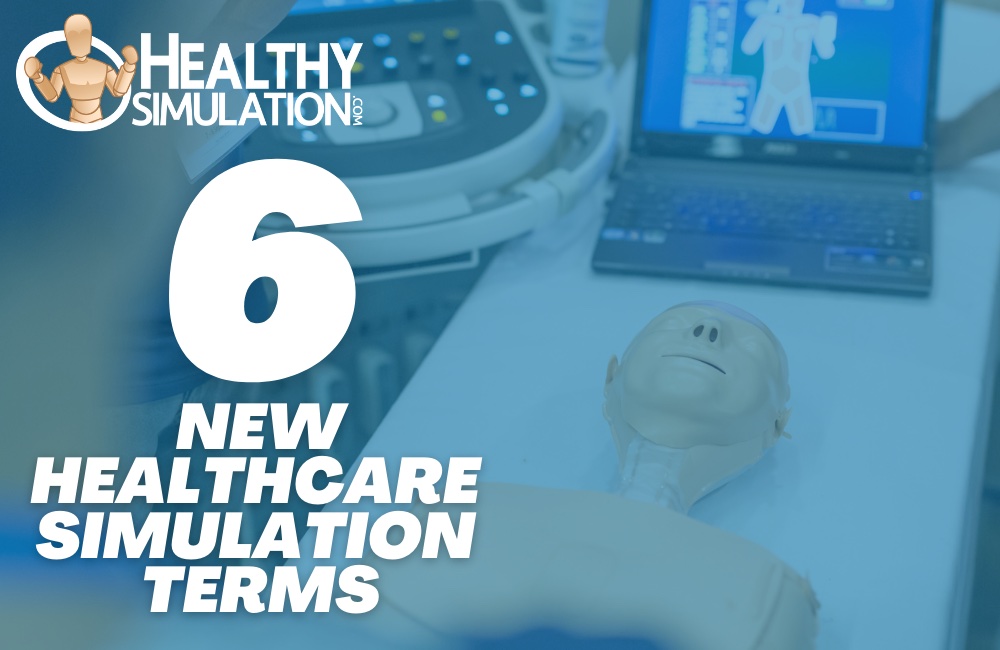6 Medical Simulation Keywords You Need to Know About
Continuing HealthySimulation.com’s coverage of medical simulation companies and industry terminology that professionals and learners need to know about, today six important keywords are explained. The following healthcare simulation topics and organizations are important to know more about as they may offer unique perspectives to help meet learner needs! Below are the next 6 medical simulation keywords you need to know about, with additional links below for even more important terms!
Augmented Reality in Simulation
Augmented Reality (AR) in simulation education is when display-based systems combine real and virtual imagery and are interactive in real time. AR systems allow learners to interact in real-world environments that are enhanced with virtual imagery. In other words, a visual display technology augments the physical environment. This happens in one of two ways: through a head-mounted display or via a non-immersive monitor-based video, respectively transparent view or window-on-the-world view.
Sponsored Content:
AR is able to create immersive, hands-on, and stimulating learning experiences using many kinds of display devices, including computers, tablets, and smartphones. Healthcare education programs are seeing the benefits and advantages that AR-based learning systems provide, including remote instruction and interactive simulations.
AR is rapidly developing, and due to its flexibility, it is increasingly used in education, including medical and healthcare education and training. By integrating physical and virtual environments, AR provides various means of delivering learning content and enhancing learners’ experiences.
There are many ways for healthcare simulation learners to gain knowledge and experience across the medical field, including acceptance to a fellowship. Known for their commitment to professional development, these programs help individual learners often through intensive training. Such training can include fieldwork, research, independent study, organizational work, graduate study, and more. Ultimately, the primary advantage of a fellowship is the ability to encounter unique experiences that are not typically available to someone in school or who are just starting out in an entry-level position.
Sponsored Content:
Typically short-term opportunities, fellowships can last anywhere from a few weeks to a few months, and in some cases upwards of a year. They are normally sponsored by an organization, institution, association, or government agency, and eligibility requirements are thereby set by the respective sponsor. A possible applicant qualification could include a record of achievement in healthcare education, as provided by letters of reference, publications, teaching evaluations, or prior specialized training or experience in medical education.
Also depending on the fellowship sponsor, there may exist the opportunity to acquire nationally competitive grants, scholarships, and other funding opportunities. Today, many fellowship sponsors also present two means of enrollment: either in-person or online. The duration of a fellowship may be impacted by whether the program is online or in-person.
The Society for Simulation in Europe (SESAM) is a healthcare simulation organization designed to encourage and support the use of simulation in healthcare for the purpose of training and research. Not affiliated with any medical or other specialties, the organization includes members with wide and varied backgrounds from within healthcare and medical education. All members have an interest and passion in medical simulation, and together they form a dynamic clinical simulation community filled with international protagonists of medical simulation across all of Europe.
With the aim to ensure the integration of simulation methodologies at all levels of healthcare as a tool to improve healthcare, SESAM’s vision is to improve healthcare through healthcare simulation. In doing so, SESAM hopes to enable safe, patient-centered care delivered by a competent and confident healthcare workforce in a well-functioning healthcare system.
Medical Simulation Course
A medical simulation course is an academic learning experience guided by a healthcare simulation-specific curriculum or focus. Learners often enroll in medical simulation courses to gain knowledge or expertise on a particular element of clinical simulation, such as nursing simulation, virtual simulation, moulage, and more. Many universities, institutions, and healthcare facilities now have medical simulation courses available to both learners and professionals so that they can help work toward great patient safety and lower rates of medical error across medicine.
Today, there are multiple ways a medical simulation course can be presented. For example, these healthcare simulation learning experiences can be taught in person on campus or take place in a clinic. The COVID-19 pandemic places a greater need for virtual learning, and now an increasing number of medical simulation courses are available for completion online, with modules available on any laptop or computer. In addition to remote learning, there also now exists the possibility to take classes in the Metaverse.
A simulation program is an educational initiative that allows learners to hone in on and practice new healthcare skills, all while improving patient safety outcomes and ultimately reducing medical errors. The goal is to deliver high-quality, realistic simulated clinical learning experiences in both discipline-specific and interprofessional environments to prepare for an evolving healthcare system. Another goal of simulation programs is to improve the competence and performance of specific simulation-based practices. This is achieved through the development of critical thinking and applying effective teamwork and communication strategies.
Healthcare simulation programs often exist across university degree programs and within medical facilities to assist in the training of learners and professionals alike. While simulation programs may encompass different focuses/disciplines and utilize individualized solutions and technology, there are several components that tend to remain consistent. For example, most medical simulation programs rely on manikins, moulage, virtual reality, standardized patients (SPs), and other clinical solutions to best convey healthcare simulation principles.
A surgical simulator is a healthcare simulation tool that can be used as a way for learners to practice surgical procedures without posing any risk to real patients. Surgical simulators can be designed specifically for a particular procedure, or more generally to be able to be used for several types of procedures (like laparoscopic surgery). As a number of clinical simulation vendors now produce these effective training solutions, surgical simulators are more accessible than ever before. This is important as the healthcare industry continues to strive for heightened patient safety standards.
Moving toward this goal, some professional licenses and certifications have even come to require that the use of a surgical simulation be completed before program completion. For example, the Fundamentals of Laparoscopic Surgery (FLS) certification by SAGES is one of the healthcare licenses that require skills demonstration through the timed performance of surgical simulation exams. This certification includes a comprehensive web-based education module that extends a hands-on skills training component and assessment tool. The tool is designed to teach physiology, fundamental knowledge, and technical skills required in basic laparoscopic surgery.
*BONUS TERM* International Nursing Association for Clinical and Simulation Learning (INACSL)
(HealthySimulation.com recently updated the INACSL page with the latest information from this prominent clinical simulation organization.)
The International Nursing Association for Clinical and Simulation Learning (INACSL) is an association dedicated to advancing the science of healthcare simulation. With over 1,800 members worldwide, the organization’s mission is to be the global leader in the art and science of healthcare simulation through excellence in nursing education, practice, and research. INACSL’s goal is also to advance the science of nursing simulation by providing professional development, networking resources, and leadership in defining healthcare simulation standards of best practice.
INACSL membership provides the education, resources, and tools that best address current challenges and help support learner, educator, and professional goals related to the learning of healthcare simulation’s latest developments. This is while ensuring that these individuals are enabled to provide the most comprehensive education and training for high-quality patient care.
Whether someone is new to healthcare simulation and is looking to understand the fundamentals or are experienced and seeking the latest updates and research, INACSL can provide them with the support they need. Membership in INACSL is based on connection, engagement, support, and inspiration.
Other Articles Covering Important Key Terms in the Medical Simulation Industry:
- 13 Medical Simulation Keywords You Need to Know About
- 11 Medical Simulation Keywords You Need to Know About
- 10 Medical Simulation Keywords You Need to Know About
- 15 Medical Simulation Companies You Need to Know About
- 10 More Healthcare Simulation Companies You Must Know About
- 14 Important Medical Simulation Companies to Know
Learn More About Healthcare Simulation News
Lance Baily, BA, EMT-B, is the Founder / CEO of HealthySimulation.com, which he started in 2010 while serving as the Director of the Nevada System of Higher Education’s Clinical Simulation Center of Las Vegas. Lance also founded SimGHOSTS.org, the world’s only non-profit organization dedicated to supporting professionals operating healthcare simulation technologies. His co-edited Book: “Comprehensive Healthcare Simulation: Operations, Technology, and Innovative Practice” is cited as a key source for professional certification in the industry. Lance’s background also includes serving as a Simulation Technology Specialist for the LA Community College District, EMS fire fighting, Hollywood movie production, rescue diving, and global travel. He and his wife live with their two brilliant daughters and one crazy dachshund in Las Vegas, Nevada.
Sponsored Content:

















